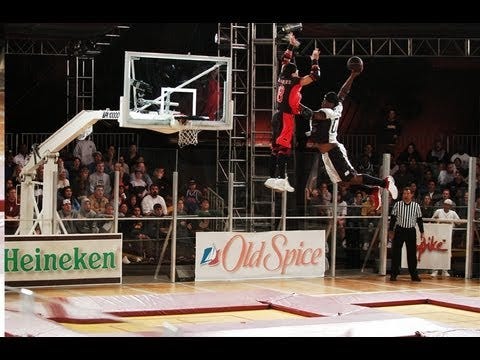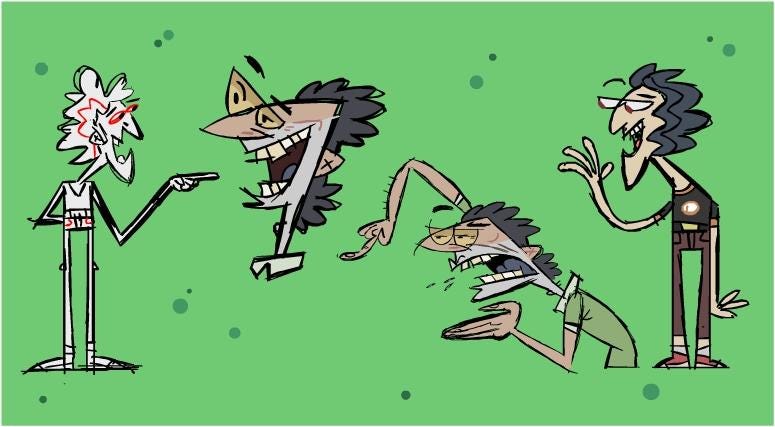SlamBall and the Era of Spike TV Sports
Those jokes that surface every March about the March Madness audience not knowing how to find truTV, which the network itself leaned into over recent years? They could have applied to Spike TV a decade earlier.
OK, so that’s not entirely true. It wasn’t officially Spike TV. But in 2001 — the first year since 1985 in which the NCAA Tournament expanded its field — the forerunner to the First Four that pit No. 65 against No. 64 aired on Spike TV’s forerunner, The National Network.
The National Network was the short-lived rebrand of country music channel The Nashville Network, not long after Viacom’s acquisition in the late ‘90s. Viacom looked to cultivate its own cable property comparable to USA Network (which NBC acquired in 2003) and the AOL TimeWarner-owned TNT and TBS.
Makes sense. The National Network’s programming, however, made considerably less sense.
Don’t get me wrong: Those few years of The National Network pre-Spike TV featured a variety of content I would select as a program director. The World Wrestling Federation’s Raw served as the channel’s cornerstone while the rest of the programing was a hodge-podge of stuff without much theme beyond appealing specifically to me.
I became a Miami Vice fan because it aired in blocks coinciding with my midday break freshman year of college. In October, TNN — excuse me, The NEW TNN, as its advertising was apt to remind the audience — went hard on the Friday the 13th film franchise.
Oh. And it showed sports; quite a bit of sports, given it was never billed as a sports-themed network.
The 2001 NCAA Tournament telecast of Winthrop vs. Northwestern State fell smack-dab in the middle of the failed XFL 1.0 experiment. TNN served as the XFL’s cable home supplementing broadcast outlets UPN and NBC.
While the league was rightly deemed an unmitigated disaster, reflected in precipitous ratings decline, an average million viewers remained for TNN telecasts. That was a respectable number for the channel at the time, and could have been a building block had Vince McMahon accepted UPN’s offer to keep the XFL going in 20021. But that’s a topic for another day.
With the closure of the XFL, TNN executives looked elsewhere for sports content. Now, this leads me to another thought but we’ll let a pin in that for now.
Enter SlamBall.
You may have seen SlamBall make headlines this past week, as the league is making a return. Several thousand early-stage Millennials like myself collectively fist-pumped as memories of throwing the experimental sport on TV for pre-party-going beers as college kids came flooding in.
SlamBall, Most Extreme Elimination Challenge (MXC for short) and the first season of the criminally underrated Joe Schmoe Show were early 2000s staple viewing, and aside from WWE Raw, literally the only programming I remember from the early days of Spike TV after its rebrand from TNN.
Spike launched in 2003 and viewed through the modern lens, very much a relic of an age that feels downright prehistoric; like if a can of AXE Bodyspray erupted inside a Jansport that also contained a year’s worth of Maxim magazines then gained sentience.
Beyond its “TV For Guys” mission statement, I never quite understood Spike TV’s intended direction. The network tried a variety of programming gimmicks, including an abortive animation block that I only know of because of the cancelled-before-it-debuted Howard Stern cartoon.
In its search for an identity, Viacom execs missed a golden opportunity to make Spike TV a sports network. CBS entered into the cable sports space much too late to make an impact, with its signature channel still remarkably difficult to get through a variety of providers.
Had Spike TV been established as the CBS sports outlet, it would have had some established market penetration and enough of a different feel from ESPN to stand out — case in point, the network’s acquisition of UFC broadcast rights in 2005.
UFC had only just begun to emerge from the depths of cultural designation a few years prior, and Spike TV was integral to its ascent as a legitimate sports league. At the end of 2021, I wrote a postmortem for Awful Announcing on the death of NBC Sports Network, and a handful of readers took umbrage with my framing of UFC’s move to NBC Sports Net forerunner Versus beginning with the first full card aired on a major cable network.
I accept the phrasing is up for contention; however, UFC’s own press releases hyping the debut on Versus as the federation’s first show on a major sports network. That spoke volumes to me, as UFC had been on Spike TV for five years at that point, reached 1 million pay-per-view buys for the first time while a Spike/Viacom partner, and was beginning to gain mainstream acceptance.
But moving to a sports-focused network gave UFC legitimacy that it never would achieve as the main attraction on the “Network for Guys.”
Perhaps if Viacom leveraged CBS properties and used the network for college basketball and football broadcasts, while using UFC, pro wrestling and SlamBall as differentiating properties, the current streaming landscape might look wildly different.
To that end, it’s fascinating to imagine how SlamBall might have grown had it not been wholly associated with the embodiment of turn-of-the-millennium bro culture.
Even just a few short years after its demise due to conflicts with the network, SlamBall was presented in a wholly tongue-in-cheek fashion as a plot point for One Tree Hill.
The game grew of a time when mainstream media aggressively pushed “extreme” sports. ESPN debuted the X-Games just seven years before the inaugural campaign of SlamBall on TNN/Spike, Tony Hawk had just become a mainstream star with his eponymous video-game series and cameo on The Simpsons, and Shaun White appeared on Mountain Dew commercials with Tracy McGrady (setting the precedent for his CNN appearance following the 2006 Winter Olympics).
SlamBall combined the attraction of death-defying extreme sports stunts with the familiarity of a popular team sport. And honestly, it worked. SlamBall was a ton of fun and a perfect background-noise sport.
Perhaps with the XFL re-relaunching after a successful comeback in 2020 stunted by COVID-19, SlamBall can find a new audience in a new era. At the very least, the redux won’t overpower the consumer with the smell of AXE.
UPN executives pitched airing Season 2 of the XFL in exchange for McMahon agreeing to cut WWF’s SmackDown! to 90 minutes and the network using it as a lead-in for an original program. McMahon balked.




